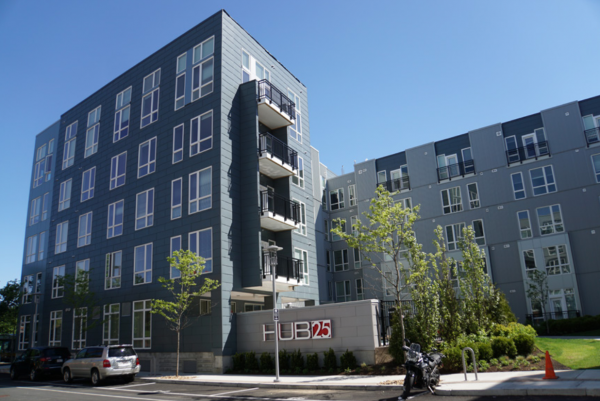August 9, 2017

Hub25, an apartment complex on Morrissey Boulevard in Dorchester, is highlighted in a new city housing report. Of the development’s 278 units, 36 are income-restricted.
Boston is exceeding its housing goals, bolstered by new concentrations of affordable middle-income stock in some of its least affordable neighborhoods, according to two recent city reviews. While slower, progress is substantial outside of the city core, officials say, as they anticipate greater investment in the outlying neighborhoods in the coming years.
Mayor Walsh’s administration released its second quarter Housing a Changing City report in July, a broad look at permitting and construction across Boston measured against the mayor’s benchmark of 53,000 new units of housing by 2030. The Boston Planning and Development Agency (BPDA) this week released its first assessment of the city’s Inclusionary Development Policy (IDP), which leverages market rate developments to build up affordable housing.
Together, they paint a picture of affordable housing distributions across a city straining against property costs and population pressures.
“Addressing rising housing costs is critical for preserving the diversity and character that make Boston a place where all residents can thrive,” the mayor said in a statement announcing the quarterly report. “We’ve seen some remarkable growth in our population over the last several years, and our goal is to lift up every neighborhood across the city by stabilizing the housing market and providing all residents and their families affordable options.”
Since 2011, the housing report notes, 21,963 units have been completed or permitted, mostly in central or South Boston, with more than 9,000 new units between them. With 1,684 new units permitted this year from April to June, the city set a 20-year record for the number of units permitted in a single quarter.
Department of Neighborhood Development data show that most of the new housing is not in multi-family homes. Dorchester has seen 1,596 new units over that time, 1,438 of them in buildings with four or more units. Only 350 new units were constricted or approved in Mattapan, on par with West Roxbury.
Mirroring a trend across Boston, they are also mostly rental. Less than 20 percent of the Dorchester new housing is in homeownership units, compared to about 27 percent citywide.
Affordability remains a key interest for the city and the Walsh administration. About 40 percent of the completed units — 13,551 since 2011 — are affordable for low and middle income households. The same ratio is expected to hold for the newly permitted units.
Including the 120 new low-income units permitted this quarter, the city is at 94 percent of its goal in creating 6,500 new low-income units by 2030. In Dorchester, 373 of the completed and permitted units are designated as restricted to low-income families making less than 60 percent of Area Median Income (AMI), or about $52,980 for a family of three.
Mattapan and Dorchester are seeing stronger growth in the lower-income development than middle- to moderate-income. While there is no jump in higher market housing in Dorchester, middle market (135 percent AMI) accounts for more than 1,000 of the neighborhood’s new units. In Mattapan, the low-income housing has outpaced every other development type.
It’s in the middle- to moderate- income range where the city has struggled but it’s seeing a bit of a rally. Affordable to those making under 100 percent AMI ($88,300 for a family of three), they account for about 2,100 of the total new units. A 17-year-old tool, IDP, has accounted for a large number of those homes.
IDP gives developers building 10 or more units three options: Designate 13 percent of those on-site units as affordable, build 18 percent of the total units off site, or pay into an IDP fund. Some developers pick a combination of those choices, and units tend to cluster around development-dense areas.
“It’s certainly not a one-for-one,” said Sheila Dillon, the city’s housing chief, “but I think certainly IDP is creating more affordable housing units in central and downtown locations. Where our traditional housing units and programs continue to work, not solely, is more in the outer neighborhoods.”
Since the introduction of IDP in 2000, the policy has resulted in 1,737 on-site and off-site units and brought in $96.8 million from private developers, according to the report. About 33 percent are homeownership units and 67 percent are rentals.
Several hundred IDP units are in downtown Boston neighborhoods like the South End, but South Boston and the Seaport have boomed with more than 400 IDP units in recent years, nearly a quarter of all such construction.
“People of middle incomes are being priced out of those neighborhoods, full stop,” said Tim Davis, housing policy manager with the BPDA. Shoring up the housing available to working families helps to “maintain economic diversity” as well as stem displacement.
IDP units are few and far between in outlying neighborhoods. Including both on- and off-site completed units, Roslindale and Roxbury each account for less than one percent of such units in the city. Mattapan’s 19 completed IDP units scrape over the one percent mark, and sprawling Dorchester’s 91 units account for five percent of the overall count.
The ratios will likely shift in the coming years, Dillon said, as development increasingly moves out of the city core.
“Early on we were seeing most of the permits being pulled downtown,” she said. “And now there’s been more of a shift to outer neighborhoods, including Dorchester. So as we see more market rate development in Dorchester, we are going to see more inclusionary development.”
The inaugural IDP report focuses on completed projects, notes Davis. Outer neighborhoods, particularly Dorchester and Allston/Brighton, “have had significant new approvals,” he said. Less so in Roxbury, Mattapan, Roslindale, and Hyde Park.
Although projects like Dot Block and the South Bay Town Center will bring a number of on-site IDP units to the neighborhood, Mattapan boasts relatively few approvals.
“It really shows that the market out there is still relatively weak in terms of market rate housing,” Davis said. And fundamentally, IDP "depends on market rate housing being built.”
The IDP report lists the Hub 25 project in Dorchester as a highlight. Built at 25 Morrissey Blvd., near the JFK/UMass T station, the Star Market, and several major throughways, the building rose from a combination of vacant land and a former parking lot. Of the development’s 278 units, 36 are income-restricted.
And several local projects benefit from the IDP fund, the most reliable way to move private development boons into other neighborhoods. The Cote Village project in Mattapan will receive $4.8 million in IDP funding, with Indigo Block is slated for $2.3 milion. The Treadmark building, which burned in a six-alarm fire early this summer, received $3.2 million in IDP funds.
Jennifer Smith can be reached at jennifer.smith@dotnews.com, or follow her on Twitter at @JennDotSmith
Topics:



